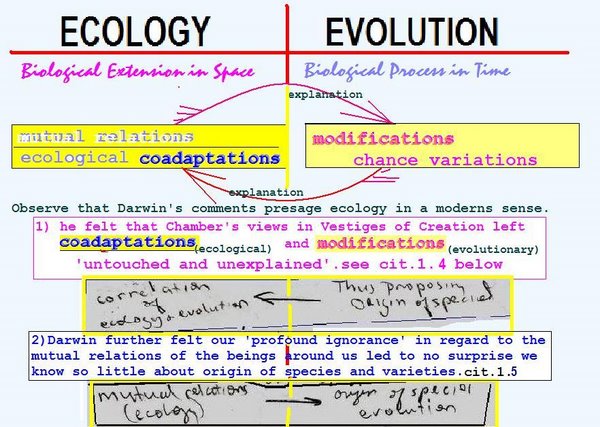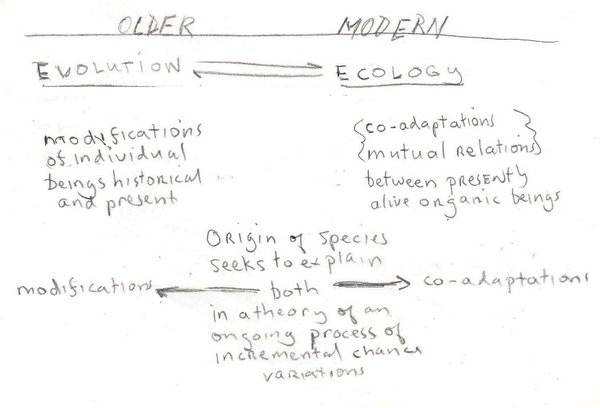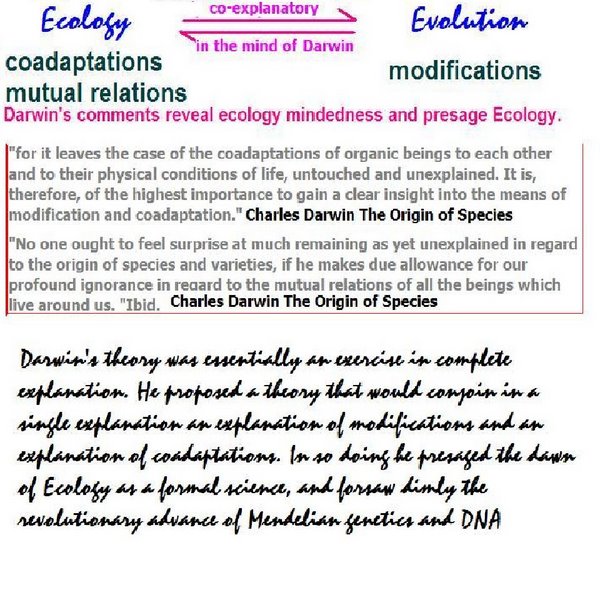editdarwin
imagimatove synthesis
~
(cit.1.0.0.0.0.2.1) "...Ptolemy and Copernicus possessed imaginative syntheses of celestial movements..." INSIGHT p.92
~
~~ For Lonergan an 'imaginative synthesis' is something like a hypothetical model or mechanism by which to understand the natural order..
~
(cit.1.0.0.0.0.2.2) "...but the laws of those movements were discovered by Galileo and Kepler..." p. 92
~
~~From an imaginative synthesis, experimental observation leads to the verification of universal laws. These are further systematized into a science:
~
(cit.1.0.0.0.0.2.3) ..."and the systematic unification of the laws was the achievement of Newtonian mechanics." INSIGHT p.92
~
~~For simplicity sake, let us suppose for the moment that an imaginative synthesis is just what may be imagined about a system of laws. We can't imagine a four dimensional space so a geometry that systematizes or unifies a set of principles for it does not lead to an imaginative synthesis. Some thought on 'imaginative synthesis' is in order because it will give an idea how mechanist determinism is an imaginative synthesis of principles found in nature.
~
(cit.1.0.0.0.0.2.5) "It is one thing to attain a systematic unification; it is another to reach an imaginative synthesis. Thus, Riemannian geometry is a systematic unification, for it provides a single set of principles and techniques for dealing with n-dimensional manifolds of various curvatures. But Riemannian geometry is not an imaginative synthesis for we cannot imagine more than three dimensions and we normally imagine only flat surfaces." INSIGHT p.92~
~~Ptolemy (after 83 – 161 AD) was a mathematician, astronomer and astrologer. In his Almagest he published tables to predict planetary positions. Ptolemy constructed an astronomical model, an imaginative synthesis, in which he placed earth at the center of the heavens. The movements of celestial objects were described by complicated paths called epicycles.
~
~~Nicolaus Copernicus (February 19, 1473 – May 24, 1543) was a Polish astronomer. In his model, called the heliocentric theory, he placed the sun near the center of the solar system and the planets in circular orbits around the sun. His De revolutionibus orbium coelestium (On the Revolutions of the Celestial Spheres), is regarded as the inception of modern astronomy and the scientific revolution.
~
~~Galileo Galilei (15 February 1564[2] – 8 January 1642), an Italian physicist and astronomer, played a major role in the scientific revolution. He performed scientific experiments and made careful observations. His observations and measurements of accelerating falling bodies, for example, led to the correction of persisting ancient misconceptions. Galileo's improvements of the refractor telescope led to a series of astronomical observations. These lent support to the Copernican theory. He studied the shadowy craters and mountains of the lunar landscape and made serial observations of the four orbiting visible moons of Jupiter. There are sixty three known moons of Jupiter of which four were visible to Galileo. Io, Europa, Ganymede, and Callisto can be seen with a 33 x telescope. These observations facilitated the perception of the structure of orbital systems such as our solar system. Due to his adherence to experimental method, Galileo has been called the "father of modern observational astronomy",the "father of modern physics", and “the Father of Modern Science.”
~
~~ Johannes Kepler (December 27, 1571 – November 15, 1630) was a German mathematician, astronomer and astrologer. He studied the astronomical data collected by Tycho Brahe, made observations of his own and found that planetary orbits are elliptical. Kepler's laws of planetary motion provide a foundation for the theory of universal gravitation advanced by Sir Isaac Newton and led to the development of field of 'celestial mechanics'.
~
~~For interest's sake here are Kepler's laws of planetary motion discovered in 1605:
1) The orbit of every planet is an ellipse with the sun at one of the foci.
2) A line joining a planet and the sun sweeps out equal areas during equal intervals of time as the planet travels along its orbit.
3) The squares of the orbital periods of planets are directly proportional to the cubes of the semi-major axes (the "half-length" of the ellipse) of their orbits.
~
~~Sir Isaac Newton, FRS (4 January 1643 – 31 March 1727) was an English physicist, mathematician and alchemist. Newton invented the reflector telescope using the parabolic mirror which he personally ground and polished to gather and focus the light from distant celestial bodies.He shares credit for the discovery of the calculus with Leibniz. Newton wrote Philosophiæ Naturalis Principia Mathematica- perhaps the greatest single work in the history of science. In it Newton presented his theory of universal gravitation and the three laws of motion. They are consistent with with Kepler's laws of planetary motion.
~
~~For interest's sake here are Newtons laws of motion:
I. Every object in a state of uniform motion tends to remain in that state of motion unless an external force is applied to it.
II. Force = mass x acceleration. The force acting on a body is equal to the product of its mass and its acceleration.
III. For every action there is an equal and opposite reaction.
~
~~The behavior of the natural order has led to the imaginative synthesis of an underlying mechanism consisting of interactive parts. A mechanical model of the universe is useful in organizing the data but is philosophically inconsistent:
~
~
ecobio4

ecobio2

coexplanatory

section 1a
In the Introduction to The Origin of Species Darwin composed the following two passages of great importance:
~
(cit.1.4) "The author of the 'Vestiges of Creation' would, I presume, say that, after a certain unknown number of generations, some bird had given birth to a woodpecker, and some plant to the misseltoe, and that these had been produced perfect as we now see them; but this assumption seems to me to be no explanation, for it leaves the case of the coadaptations of organic beings to each other and to their physical conditions of life, untouched and unexplained. It is, therefore, of the highest importance to gain a clear insight into the means of modification and coadaptation." Charles Darwin,The Origin of Species Introduction.par. 6/7
~
(cit.1.5) "No one ought to feel surprise at much remaining as yet unexplained in regard to the origin of species and varieties, if he makes due allowance for our profound ignorance in regard to the mutual relations of all the beings which live around us. "Ibid. par.10
~
It is impressive how deeply immersed Darwin was in ecological considerations. It was his starting point, and the unremitting evidence of coeval modifications of varieties and species in the fossil record he could not separated from it.
~
A thoughtful reading of the two passages by Darwin, (cit.1.4 and cit.1.5) which significantly were placed no more than three paragraphs apart in his Introduction to The Origin of Species suggests that Darwin had, perhaps unwittingly, experienced a penetrating insight into their connection. In these passages, he argued that an explanation of the origin of species would be enhanced by an understanding of the ecological presentation of mutual relations between living organisms; just as he argued that a better explanation of ecological coadaptations of organisms to each other and to their physical conditions would require an understanding of the variations and modifications that occurred in varieties and species. So it would seem his insight was to unite the epochal or evolutionary with the present ecology.
_______
The following from Vestiges of the Natural History of Creation (1844), written anonymously but later attributed Chambers. It is the source of Darwin's contemplations in cit.1.4 and cit.1.5.
It is a most enjoyable work: e.g.
~
(cit.1.6) "The giraffe has in its tall neck the same number of bones with the pig, which scarcely appears to have a neck at all." Vestiges of the Natural History of Creation (1844)
~
(cit.1.7) "The whole train of animated beings, from the simplest and oldest up to the highest and most recent, are, then, to be regarded as a series of advances of the principle of development, which have depended upon external physical circumstances, to which the resulting animals are appropriate. I contemplate the whole phenomena as having been in the first place arranged in the counsels of Divine Wisdom, to take place, not only upon this sphere, but upon all the others in space, under necessary modifications, and as being carried on, from first to last, here and elsewhere, under immediate favour of the creative will or energy. [As footnote by Chambers: When I formed this idea I was not aware of one which seems faintly to foreshadow it-namely, Socrates's doctrine, afterwards dilated on by Plato, that "previous to the existence of the world, and beyond its present limits, there existed certain archetypes, the embodiment (if we may use such a word) of general ideas ; and that these archetypes were models, in imitation of which all particular beings were created.]" Chambers VESTIGES.
_____________
Lonergan himself has some criticisms of Plato's theory of the Immutable Ideas. In his work Method in Theology he writes:
~
(cit.1.8) "At a certain stage in Plato's thought there seem to be asserted two really distinct worlds, a transcendent world of eternal Forms, and a transient world of appearance. " MIT Chap 3
~
By and large Lonergan is against there being two really distinct worlds. So at least there is a measure of consistency in finding that Lonergan's theory works well with Darwin as opposed to Chambers.
section 1
My purpose is to associate several writings of Charles Darwin and Bernard Lonergan, S.J. In so doing I will indicate how Lonergan's thought can bring to light a scientific understanding and a scientific will, namely Darwin's. I shall further show that Ecology, a newer science*, contained within the field of Biology, a study of the coadaptations and mutual relations between living things with one another and with their environment, today has arisen to meet an explanatory need, to fulfil an explanatory relation with the concepts of 'modifications', 'chance variations', and change contained within the theory of evolution also contained within Biology. Darwin's theory of evolution is the transition to a new model of creation for the life sciences, one which involves probability, and probability of survival. The meaning of probability as it is used here is discussed in INSIGHT which was one of Lonergan's major works.
~
Finally, I will explain why Darwin's notion of natural selection was a revolution in science, or more correctly, presaged and prophesied an actual revolution. The power of Darwin's theory did not depend on the psychology of a blow to man's narcissistic self-image**, nor of a displacement of man's anthropocentrism in the manner of a Copernican revolt. Nor does it take its force from the fashionable anti-theism of the new and non-teleologic age of science; nor even from the theatrical drama of species in a fight to the death for survival. Darwin's idea, I believe, drew its power from a simple single factor, his unique and early grasp of explanation.***
~
Darwin, I contend, was ecologically oriented in a modern way, the orientation of his knowledge due to an insight, and he looked upon the many living organic beings as well as those of the fossil record and saw that their coadaptations and their mutual relations which he also observed could not be engineered into the formation of biomes, or shaped into theories, except in light of a a few intelligible processes that he grouped under his own theory of natural selection of chance variations.
~
Any process occurs in time although its visible results are extensive in space. In the case of biological process, it is manifest in the biome and habitat as well as in the living organism. So processes which resulting in coadaptations and mutual relations of organic beings; or in the homeostasis of a single organism must also conduct their work, so to speak, by extending from the past and continuing into the future. The explanation then would be invariant in space and time, four dimensions.
~
Darwin's concern was for an explanation of temporal development in its relation to spatial relationships of living organism. From this one might say Darwin's theory seems almost Einsteinian because the Darwinian theory of Origin of Species, 1) if suitably abstract, and at the level of correlations and laws, (see cit.1.1) would exist outside of particular time and space, and; 2)if true in a scientific sense, that is, supportable, probable, estimable, must be invariant and continuous, i.e. applicable without major revision, in all of life, in all times and all places. Were its machinations timeless and not limited to a particular time and place, It would be best ultimately explained perhaps as contained in a space-time continuum. The intelligibility of life would tend to be explained independent of the space-time continuum. This is not far afield from Lonergan who points out in a discussion of invariance of scientific laws:
~
(cit.1.1) "all scientists expect their correlations and laws to be independent of merely spatio-temporal differences" INSIGHT Chap II.2.5
~
The fact, and the observation I wish to impart, is that Darwin shared in the renaissance of a fully intelligibility based idea of science that more obviously manifested itself around the end of the nineteenth century. In addition to obliging the life science to follow this course, it is arguable that Darwin also bears the distinction of having been one of the earliest members of this late century renaissance.
~
Invariance of abstract theory is much the province of the work of Bernard Lonergan who took an original approach to scientific reasoning and method. He begins with a contemplation of 'insight into insight', discovering that an 'insight into insight' would be in some sense a 'knowledge of knowledge' and a 'clear and distinct idea of clear and distinct ideas'. His plethora of scientific examples in demonstration of this make up a major part of his work in INSIGHT. This suggests that second only to his call for 'self appropriation' by means of hashing out one's own insights into insight, and these may often be quite peculiarly one's own but in a satisfactory and salutary way, is the effect of a 'conversion' on our knowing. Lonergan does say that in this intellectual conversion of insight into insight we might undergo a reorientation**** of what we know. I suggest that Lonergan could capture and depict the 'glimmer' that I think Darwin had (and perhaps nurse it to a purer flame in his theory of Emergent Probability); and that, after struggling a bit to understand Lonergan, some valuable insights may be had into the scientific insights such as that of Darwin. I hope to relate Darwin's 'ingenious insight' to Lonergan's view of conjugate form, and sense of formal causality and then to his notion of 'dialectic'.
~
Darwin's insight then was that there must be a certain explanatory correlation between chance variations and modification occurring in a temporal epoch with the mutual relations and coadaptations of living organisms in a spacial habitat or biome. He gathered a wealth of botanical, zoological, and fossil data, from not only direct observation but also from his reading and discussions with those involved with artificial selection in animal husbandry and horticulture. He provided us with a scientifically plausible model of biological process and progress.
~
Bernard Lonergan wrote INSIGHT during the mid-twentieth century, at a time when the formal science of Ecology was only dawning in popularity and not quite well known *****, but he examined the intelligible underpinnings of the sciences and he identified the intelligible underpinnings of biology with 'in a word, evolution'. His enthusiasm for Darwin and evolution is fairly evident:
~
(cit.1.2) "Biology has become an explanatory science by viewing all living forms as related to one another in that complex and comprehensive fashion that is summarily denoted by the single word, evolution." Bernard Lonergan, S.J. INSIGHT Chapter IV Sec.3
~
(cit.1.3) "There are those that date the dawn of human intelligence from the publication of Darwin's Origin of Species in 1859. In fact, though the work does not contain any systematic statement of methodological foundations, it does present the outstanding instance of the employment of probability as a principle of explanation." INSIGHT LONERGAN IV.3.3
~
The Introduction to The Origin of Species reveals an implicit interest in things ecological bright in the mind of Darwin. Darwin thought an explanation of the origin of a species would be incomplete unless coadaptations between living organisms, and the modifications that occur in individuals were recognized, considered, and the pattern of their mechanisms of interaction, empirical or logical, at least considered as part of a single explanation even if not fully explained as yet.
~
Darwin I think wanted, yearned for an explanation that would relate mutual relations and coadaptations between organic beings to modifications in individuals in the present, and satisfy his interest in the explanation of the fossil record by linking present to past in the same theory . In seeking a way to recognize both and consider the possible mechanisms of their interactions Charles Darwin advanced his theory of the Origin of Species. Lonergan's enthusiasm for the 'Darwinian World View' was tempered somewhat by his realization that even so an extensive a claim about biological process is still only a theory of a particular case, the case of life on this earth. It would still requires complete verification at an empirical level, and this would require an excursion of all instances of evolution. Thus, in Lonergan's view, it begs for an explanatory underpinning of its own, one with immanent and complete intelligibility, and Lonergan claims to have moved towards this, or even accomplished it, in the theory of 'emergent probability'.
~